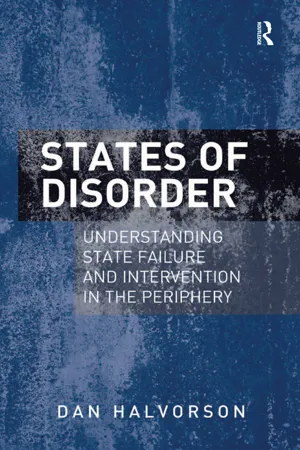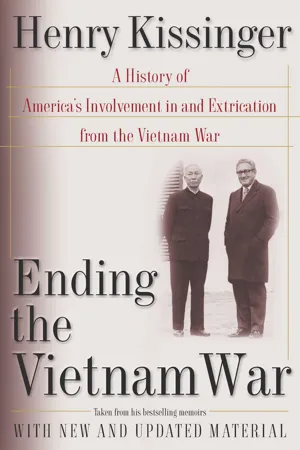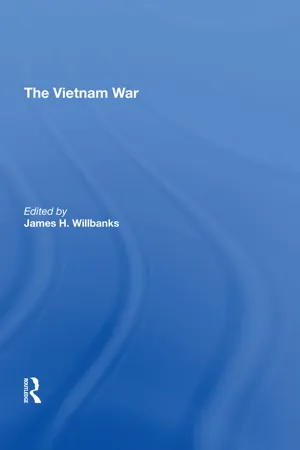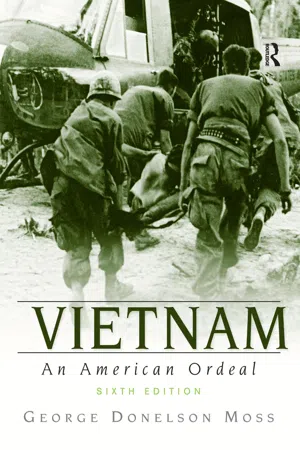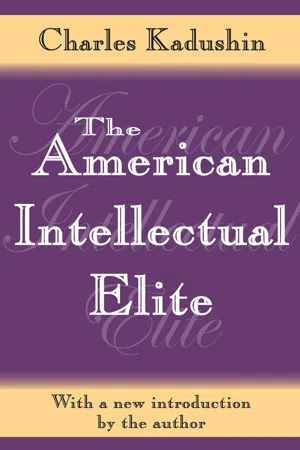History
US Involvement In Vietnam
The US involvement in Vietnam refers to the military, economic, and political intervention of the United States in the Vietnam War from 1955 to 1975. The US supported South Vietnam in its fight against the communist North, deploying troops and engaging in heavy bombing campaigns. The conflict resulted in significant loss of life and had a lasting impact on US foreign policy.
Written by Perlego with AI-assistance
Related key terms
8 Key excerpts on "US Involvement In Vietnam"
- eBook - ePub
The Vietnam War
A Study in the Making of American Policy
- Michael P. Sullivan(Author)
- 2021(Publication Date)
- The University Press of Kentucky(Publisher)
The data presented in the preceding chapters suggest that we should not treat Vietnam merely as an isolated aberration in American history, a unique event that can now be forgotten. Nor should we explain America’s involvement in that war simply in terms of a few decisions that “got out of hand.” To restrict analysis in this way is to restrict the type and scope of implications that can be drawn from American involvement in the Vietnam War. The war and the decisions producing it took place within an unfolding dynamic containing several crucial factors in a way militating for further American involvement, and not against it, and it is unlikely that a replay, with the same factors involved, would radically alter the outcome.What were those crucial factors? First, while Vietnam for many years was not an important issue, decision makers nonetheless perhaps unwittingly allowed it to become one of overriding concern once early decisions had been made for involvement. Second, the public favored the war and as those early decisions were being made, the public, and the leading decision makers, were still engrossed in their extroverted view of the world. The American involvement in Vietnam was justified as part of the larger, Cold War policy of Russian containment; even though, while that justification was used time and again, the Vietnam War itself had virtually no effect on that Cold War. Relations between the two major protagonists continued in the cooperative direction (with only one deviation) that had been underway for almost twenty years.On a yet larger scale, international violence had decreased prior to the major escalations of the war, possibly setting the stage, in the broadest sense, for yet another increase in such international violence somewhere in the world. In addition, the relations between the major powers in the world had undergone change, the primary one being the beginning demise of the United States as the recognized hegemon; and there is some evidence that when a hegemon declines, nationalist wars like the one in Vietnam, rather than other types of wars, are more likely to break out. This in no way means that the United States, or whatever hegemon may have been in existence, was destined to become involved in such a war, but only that in terms of the type of war likely to break out at such a time, nationalist wars would rank high in probability. - eBook - ePub
- Loramy Gerstbauer(Author)
- 2016(Publication Date)
- Routledge(Publisher)
The Vietnam War was the most divisive period in the United States during the twentieth century. The war caused intense debate over national identity, calling into question the foundational myth of American exceptionalism, which portrays the United States as a pure, selfless, and nonimperial nation (Fry 2006, 175). The debate over Vietnam continues to affect U.S. foreign policy long after 1975, and the lessons of Vietnam were evoked in the Persian Gulf War, the 2003 Iraq war, and, as noted already, in Obama’s response to the Syria conflict in 2014.The Vietnam War extended beyond the nation of Vietnam into neighboring Laos and Cambodia. For the Vietnamese, the conflict also extended beyond the timeframe of U.S. involvement, which was from 1954–1973, heightening in 1965 with an air campaign and then ground troops. Although the Vietnam War involved different theaters in Southeast Asia, the focus of this analysis is on the relations between Vietnam and the U.S. only. The analysis also puts little emphasis on reconciliation between North and South Vietnam, except where it factors into U.S.-Vietnamese relations.A Cold War Proxy War
U.S. goals in the war must be perceived through the lens of the Cold War. The U.S. sought to reduce the threat of Sino-Soviet domination of Asia, to thwart “wars of national liberation” in developing nations, and to otherwise halt Communism and its threat to peace and stability in Asia. The U.S. also expressed a goal of promoting democracy and free trade and investment (Kenny 2002, 129). The fear of collapsing dominoes of Communism was real. John F. Kennedy cautioned that “Vietnam represents the cornerstone of the Free World in Southeast Asia, the keystone to the arch, the finger in the dike. Burma, Thailand, India, Japan, the Philippines, and obviously, Laos and Cambodia are among those whose security would be threatened if the red tide of Communism overflowed into Vietnam” (14). Likewise, President Lyndon Johnson viewed Vietnam through the lens of the Communist tide. He justified his 1965 decision to send troops into South Vietnam in terms of a “Jakarta-Hanoi-Beijing-Pyongyang axis, with Cambodia probably to be brought in as a junior partner and Laos to be merely absorbed by the North Vietnamese and the Chinese” (117). The war was also viewed as a defense of South Vietnam against the aggression of Communist North Vietnam. According to President Johnson, “Our purpose in Vietnam is to prevent the success of aggression. It is not conquest; it is not empire; it is not foreign bases; it is not domination. It is, simply put, just to prevent the forceful conquest of South Vietnam by North Vietnam” (14). The degree to which the war can be understood as one of northern aggression is still debated. To what degree was there genuine rebellion in South Vietnam, with South Vietnamese Communists rebelling against the South Vietnamese government, and to what degree was North Vietnam controlling these entities in the South such that the conflict was more of a North/South Vietnamese conflict? (Nguyen 2006). - eBook - ePub
America and the Vietnam War
Re-examining the Culture and History of a Generation
- Andrew Wiest, Mary Kathryn Barbier, Glenn Robins(Authors)
- 2009(Publication Date)
- Routledge(Publisher)
1 These works incorporate the dominant trends in diplomatic history over the past few decades, such as exploring the international dimensions of the conflict and the intersections of culture and foreign relations. They also have much in common with previous historians of the war. Although the authors came of age after the war was over (or when it was in its final years), they passionately defend or critique American policies in Vietnam. And like their predecessors, they focus on a central question in the historiography: How did the United States get involved in Vietnam? In doing so, the authors focus on the period up to 1965, thus ignoring the peak years of American involvement. This focus reinforces the conclusion that the outcome of the war was preordained, or at least overwhelmingly likely. For many current and past historians, the steps toward Americanization are more important than the story of the war itself.In Choosing War, Fredrik Logevall explores the decisions that Americanized the Vietnam War during the late-Kennedy and early-Johnson administrations. While primarily domestic in focus, Choosing War also describes the international atmosphere in which these decisions were made and the international repercussions of American actions. In Assuming the Burden, Mark Lawrence describes the development of French, American, and British cooperation in opposing the Viet Minh in the late 1940s. Lawrence’s balanced account of the major Western actors internationalizes the history of the conflict in Vietnam. Mark Bradley’s Imagining Vietnam and America internationalizes the conflict in a different way: by exploring the roles of the Vietnamese themselves. He mostly eschews diplomatic decision making, exploring instead the cultural components of Vietnamese–American relations in the first half of the twentieth century. In America’s Miracle Man in Vietnam, Seth Jacobs also demonstrates the importance of culture—in this case, race and religion—in understanding America’s commitment to Ngo Dinh Diem and South Vietnam. Mark Moyar’s Triumph Forsaken - eBook - ePub
States of Disorder
Understanding State Failure and Intervention in the Periphery
- Dan Halvorson(Author)
- 2016(Publication Date)
- Routledge(Publisher)
5 United States' Intervention in South Vietnam, 1965 DOI: 10.4324/9781315610733-5This chapter examines the book’s second case study of US armed intervention in 1965 to prevent the state ‘collapse’ of South Vietnam. The Vietnam intervention took place in the postcolonial pattern of order and bipolar international system of the Cold War. The direct US combat intervention in Vietnam, beginning with air operations from February 1965, and with ground forces from July 1965, can be understood as a response to a normative threat to Washington’s expectations for international order in a sensitive strategic location. By early 1965, the impending collapse of the Republic of Vietnam (RVN) in the south of the country was a fundamental breach of Washington’s requirements for a stable, non-communist ‘free world’ order in the postcolonial periphery.The US identity narrative held that preponderant American power bestowed on Washington a special burden of responsibility to preserve a pluralistic liberal world order by containing communist expansion. Developments in Indochina in the 1960s were a direct challenge to the US responsibility for preserving freedom in the world and therefore to its ontological security needs. As mentioned in Chapter 3 , in the Cold War climate of zero-sum ideological and strategic bipolarity, international order requirements and the distribution of capabilities were tightly interlocked. The collapse of South Vietnam was considered by most policy-makers as a profound strategic risk in the tense early-1960s Cold War climate even though it presented no direct security threat to the United States. The domino analogy entrenched in 1954 by President Eisenhower placed great emphasis on the transmission of peripheral threats to the North Atlantic core (Snyder 1991 - eBook - ePub
Ending the Vietnam War
A History of America's Involvement in and Extrication from the Vietnam War
- Henry Kissinger(Author)
- 2003(Publication Date)
- Touchstone(Publisher)
34 And in June 1961, as we have seen, Kennedy defined Vietnam as the place to vindicate American credibility.Each new administration obliged to deal with Indochina felt compelled to take another step into the morass. Truman and Eisenhower had established the military-assistance program; Kennedy’s emphasis on reform led to growing American involvement in the internal politics of South Vietnam. The problem was that reform and nation-building in South Vietnam would take decades to bear fruit. In Europe and in the 1940s and 1950s, America had bolstered established countries with strong political traditions by extending Marshall Plan aid and by means of the NATO military alliance. But Vietnam was a brand-new country and had no institutions to build upon. The central dilemma became that America’s political goal of introducing a stable democracy in South Vietnam could not be attained in a time span relevant to the needs of a victory over the guerrillas, which was America’s strategic goal. America would have to modify either its military or its political objectives.When Kennedy entered office, the guerrilla war in South Vietnam had reached a level of violence sufficient to prevent the consolidation of the Ngo Dinh Diem government without as yet raising doubts about its survival. This seeming plateau of guerrilla activity tempted the Kennedy administration into the belief that a relatively small additional effort could achieve complete victory. The temporary lull, however, was due primarily to Hanoi’s preoccupation with Laos; it turned out to be the calm before the storm. Once the new supply routes through Laos were opened, the guerrilla war in the South began to accelerate again, and America’s dilemmas grew progressively insoluble. By the fall of 1961, the security situation had deteriorated to a point where it could only be alleviated by some kind of American military intervention. General Maxwell Taylor, the President’s military adviser, and Walt Rostow, director of the State Department Policy Planning Staff, were sent to Vietnam to develop an appropriate policy. The real purpose of their mission was to determine the scale and the manner in which America should increase its commitment, not whether to undertake it. - eBook - ePub
- James H. Willbanks(Author)
- 2017(Publication Date)
- Routledge(Publisher)
ASEAN ), the organization that once united the Southeast Asian noncommunist “dominos.” These two events underscore an important fact: that the official rationale for the Vietnam War—that Southeast Asia would slip into the communist orbit if the United States did not prevail in Vietnam—has not held up in the light of history.But a new ex post facto argument for the war has emerged from the ashes of that original rationale: that the United States military intervention bought Southeast Asia a decade in which it could consolidate its internal security and establish the foundation for the rapid economic growth that followed. This rationale was first advanced a decade ago by Henry Kissinger, President Richard Nixon’s national security adviser. “America failed in Vietnam,” he wrote in the April 8, 1985, issue of the International Herald Tribune, “but it gave the other nations of Southeast Asia time to deal with their insurrections.”The most elaborate version of this argument portrays Southeast Asia in the early 1960s as “extraordinarily vulnerable” to armed communist insurgencies and subversive movements that were receiving political and material support from Beijing. It asserts that communist guerrillas were growing in strength in northeast Thailand, Burma, and the Philippines at the same time that Malaysia faced a lingering communist guerrilla movement deep in its jungles; that communists were fighting to control Singapore and threatening the much larger prize of the Malaysian Federation until Singapore was expelled in 1965 for fear of a communist takeover there; that Laotian communist insurgents were poised to take power; and that neutral Cambodia was already accommodating communism in Indochina. - eBook - ePub
Vietnam
An American Ordeal
- George Donelson Moss(Author)
- 2016(Publication Date)
- Routledge(Publisher)
15 U.S. officials had tried to keep a low profile; they had endeavored to let the South Vietnamese develop their own version of democratic elections. But in the end, the Americans interfered enough to poison the whole political process. The new government neither validated democracy nor respected the rights of its opponents. But the Thieu-Ky victory, however dubious it might appear to be within a Vietnamese political context, meant that the military junta would remain in power, Americans would remain in South Vietnam, and the war would go on. Behind the democratic facade and U.S. officials’ spin, the South Vietnamese leaders continued to provide inefficient authoritarian governance.From mid-1965 to the end of 1967, while the Americans escalated both the air war against North Vietnam and the ground war in South Vietnam, the South Vietnamese government failed to eliminate its underlying political weaknesses. Pacification floundered, and the Thieu-Ky regime remained a narrowly based military directorate dependent on continuing American support to remain in power. The large-scale U.S. military effort could not compensate for the continuing failure of the South Vietnamese to erect a strong, stable, and popular government or to build a viable nation. The American war proved either irrelevant to nation-building or exacerbated its problems. The continuing political failures of the Saigon regime were a major cause of the eventual U.S. failure in Vietnam.The impact of the U.S. war—with its half-million troops, thousands of civilians, and billions of dollars—strained and disrupted the South Vietnamese economy.16 Saigon became a boomtown whose prosperity was based on a single industry, war. The former “Paris of the Orient” became a crowded, noisy metropolis, its streets clogged with traffic and its hotels, restaurants, bars, nightclubs, casinos, and brothels teeming with American soldiers, civilian advisers, journalists, and tourists. Many Saigonese found work providing services to the Americans and to their fellow Vietnamese who profited from the war economy. Corruption became a way of life for many South Vietnamese officials. They siphoned off large amounts of U.S. aid in a variety of ways. In many cases, U.S. agencies paid millions of dollars for imaginary goods and services that were never provided. The black market became a big business trafficking in huge amounts of stolen American consumer goods, weapons, and illegal currency exchanges.17 - eBook - ePub
- John Sommer(Author)
- 2017(Publication Date)
- Routledge(Publisher)
The Vietnamese war illustrates the extraordinary limitations of the use of power by a highly advanced society over a relatively backward, primitive society. This means that the whole concept of counterin-surgency, and so forth, has to be rethought. Second, it seems to me that the Vietnamese involvement indicates that the American people will not stand prolonged warfare, even of a limited type, and, hence, there will be overriding pressures, either toward military disengagement or rapid all-out victory — a kind of simplistic black-and-white approach to international politics which at times can be very dangerous.If American power is limited, the lesson learners conclude, then there has been too much emphasis on the military.The military were able to determine it [policy] because the politicians didn’t know what to do. It is very difficult to formulate political policy for the U.S. in a part of the world which is not understood. . . .The most radical consequence of the war in Vietnam was a growing disbelief in the doctrine of the “international Communist conspiracy.” A reexamination of Cold War bellicosity often accompanies this change. Many lesson learners may not have fundamentally changed their foreign policy positions, but as a result of the war they have begun to reexamine their basic assumptions. An editor of an intellectual journal is typical of this group:Yes, I’m more dubious about a wide set of policies that we continued with probably into the late fifties and early sixties that really we didn’t have to. In other words, for example, I think that to hear Kennedy’s inaugural today would be a rather shocking experience. I mean, it would sound almost bellicose and, I have a feeling, a bit old-fashioned.6
Learn about this page
Index pages curate the most relevant extracts from our library of academic textbooks. They’ve been created using an in-house natural language model (NLM), each adding context and meaning to key research topics.



